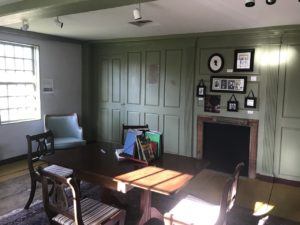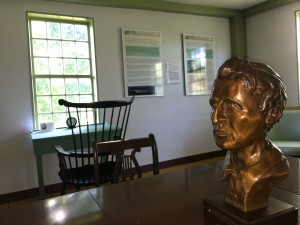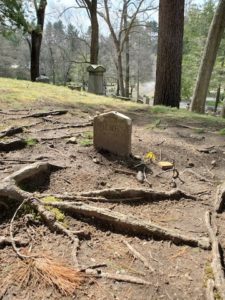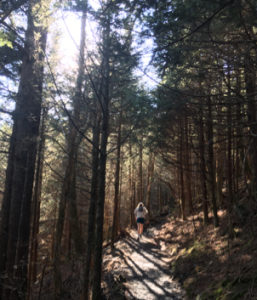By Sandy Stott

Henry David Thoreau’s birthroom serves as a writers’ retreat. Credit: Margaret Carroll-Bergman
In your first room, the one where you sleep, and, at many hours, take in the light as it shifts and illuminates (or shadows) the faces (and the face) that appear above you, there’s a lot to see. Everything asks for your eye. And the other four senses chip in too. It is all incoming. Life that is.
We can’t return to the mystery of that long intake and our squalls of comment. Whatever remains from our first months of life is narrated by others, or stored in film clips of some “other” crawling about a screen, or simply waving limbs. “Who is that?” we wonder as we watch our little, former selves; what was it like?
***
The morning light streams through the east window of Henry Thoreau’s birth room, where, as summer slipped into fall in 1817, he passed hours of time absorbing. It is a ho-hum February day with only a hint of the corona-horizon in the offing, and I am receiving the gift of time to think and write in Henry Thoreau’s birth room, the centerpiece of the Thoreau Farm Trust’s restored and vital birth house.
What’s it like to be given time in the presence of? Here are a few notes, unvarnished observations and thoughts from that day. They are beginnings … as any birth will be.
I hope that, as we reach beyond our current isolations, you too may find your way to this gift … or a similar one.
Selected Notes from 2/22/20:
Pre-amble: East-facing, twelve-pane window. Outside, windless, just below freezing, cloudless — a replica of yesterday. Inside, at this replica-desk, built to the dimensions of Thoreau’s desk at Walden; it raises my arms to write. My eyes, I note, get raised too.
On this still, winter morning, in this sunlit room, with a hint of sun-warmth, I have come to spend hours emptied of obligation, to attend … if it seems the right attention … to these hours in the life of the ash tree beyond the window. Or to the verge of woodland brush some yards beyond. Or the wooded interior of my mind. To attend also to new writing about a local stream many miles north of here in Brunswick, Maine. It is, as I wrote on a first piece about it, (no) Mere Brook.

Thoreau’s birthroom. Credit: Margaret Carroll-Bergman
When I got here, I read my way around the birthroom, paying particular attention to the short bios and old representations of the Thoreau family. The four siblings drew a long look; passing from one to the next, I traced the family resemblance, returning often to their eyes, which seem outsized for the faces they inhabit. I suppose I can say now that I’ve felt the gaze of Thoreaus. It felt a little like looking through clear ice.
It is quiet, but for a passing car every so often, and the clock, still set on daylight time, which ticks by the seconds, compiling the minutes, and is — I’m guessing — here to complement Cynthia Thoreau’s memory of stoop-sitting as a child late at night, and hearing only “the ticking of the clock in the house behind her.”
I’ve brought current writing to this day, though I’m uncertain whether or not I’ll turn to it. These notes in my Future is Local notebook may be the day, spiced perhaps by water-readings I’m carrying: (David James Duncan’s’s My Story as Told by Water and Franklin Burrough’s Confluence). I’ve also brought two pencils, which I’ve sharpened for note-making in my scatter-book. And I have two Henry-books — Walden, of course, and Faith in a Seed. The Walden edition is my first teaching copy, and so is filled with notes, many rudimentary; after years of teaching, I see many of my notes as kin to those taken in high school or college, when, following advice to be an “active reader,” I might have written “metaphor” in the margin next to (I hoped) the same.
But some of these notes or checkmarks or underlinings caught passages that deepened over time, that I returned to again and again as I sought to open little windows for my students (see memory of Henry sprawled on the new ice of early winter/late fall, looking down through his “window” into the pond and its winter beings and stories). Or refresh my own sense of a work as bottomless as Walden Pond.
It is, these notes later, morning still, even as the sun has edged south and heated the air outside enough to stir the twigs on the ash.
“Write while the heat is in you,” says one of the many quotations before and around me. Kindle that heat every day, it might say, as in you must set the matter of your fire up and ablaze; no one else will do it for you.
I wonder if Thoreau had a well muscled tolerance for boredom and the limits of self, which I take to be one of writing’s primary problems. “Well, I showed up at this desk again and found … the same self, the same “selfie.” It would, of course, help to have Henry’s genius, to have a mind so capable, but still that mind was not unencumbered, and that mind was not his full self. Surely that’s part of what sent him walking every day that he could.
As Franklin Burroughs writes in his introduction to Confluence, the walker strikes a deal with the earth every step (paraphrase from memory). Relationship! the way out of the tight circle of self.
From earlier writing, a good deal so:
Declaration
Two years, two months, two days.
Henry Thoreau was wary of symbols
thoughts and things that go two
by two into the ark of the mind.
And when he took time off, absconded
with it to the pond on July 4th,
1845, he scoffed at those who saw
declaration of independence, in truth
he might have said, I am more
dependent than ever, on this pond
on this earth, on these feet, not
to mention the sky that shines
in the water, a medium really
for seeing up and down, for
seeing two ways at once, a unity
upon which I row my boat and
in which I bathe every day.
***
That was the first hour.
Yesterday, partly as prep for today, I walked to and through Estabrook Woods. Getting out of town took some time…and wariness — the commuter cars were plying the back road, looking to hurry to some edge amid the general swarm of traffic. But once turned onto the dead end of Estabrook Rd., I was solo, and, where the walkers’ cars are usually five or eight deep, there were none.
Into the woods then, along a track of scuffed and fragmented leaves, with only occasional remnants of foot-beaten ice and some frozen mud. North along the Carlisle Road, and fresh from Maine’s woods, I am — once again — amazed the the size of the trees in his old forest. Yes, of course, the white pines, some of which must be verging on 150+ years. Hardwoods also have escaped the saw; some of them are two-people thick. As befits lordly trees, the forest floor is free of scrub brush.
That memory nudges me to run; my feet know this glacial rubble, even down to some individual stones; I break into a small-stepped shuffle wherever the trail climbs. Which it does along the esker that rims Stump Pond’s north side. I have always liked running uphill … tap tap tap, it is all so … me.
From beneath the hill at Punkatasset, I turn south, small stepping up the ridge rise, the tipping down toward town. I run through a few new signs that say, “Don’t,” and “Private Property.” These are cross-lots moments. I have some sympathy for the landowners as these woods get crowded with walkers and bikers and dog-annoyers who pop up in yards, asking the way, or trampling on. We are too many on many days. But on this one, I have seen four people in an hour; the 4 o’clock light slants in. I’m not even leaving prints on the hard ground. I cross over, cross up our confused notions of private property.
Is property private when you are the only one there?
I alternate: when I walk, I tree-gaze. These woods are worthy of intense attention; when I little-step run up the trail, I mind the rocks and their vests of leaves. There’s a lot to read on such a trail, and each right step is a little pleasure. Linking them is foot-writing, script of motion.
I am, I realize repeatedly, happy, very.
***
Through lunch — a croissant, an orange, some water — simple fare. The sun is in the south, warming the room still, some. I feel the day’s turn. Morning’s freshness has worn away; there’s a skim of usual across my mind — my thoughts, my words; I know them, you, him. Still, these morning hours untethered from e-mail and word-games and news-sites have been good. They suggest better practice when I return to my own room.
Now would be time for a walk, but today I’ll stay on at this desk, before this now-cool window, in this always calm room. I’ll see what appears, whether morning-mind comes again, or sends some afternoon sibling.
***
Back with the ash, whose branches show the way so much expresses from the single fact, and how much depends upon that fact, trunk.
The sunlight has reached the foot of my chair, welcome foot-warmer in this cool room.
Franklin Burroughs at the end of his introductory essay in Confluence:
So if you sit in your boat in the middle of the bay on a sweet late summer morning, your sense will be of a surprising solitude and of lovely modulated distances, and your pleasure in that will be augmented by the old pleasure, which must be rooted in our hunter-gatherer heritage, of being surrounded by life, seen and unseen. Human and natural history appear to have settled into a peaceful co-existence. In fact they have not — not here, not anywhere else on earth. Part of your mind knows that, and it is important not to ignore what you know. But it is also important to see what is, at and for the present moment, in front of your eyes. (p.8)
Just so. Kindred surely to Henry.
***
Part of this day’s lesson, I/he said, returning to this day, to this room, lies in having stuck with it. That’s so old and obvious as to be no lesson at all, and still, it insists. Here, I have been quieter, more persistent; I have let whatever shallow seep there is pool to where I can drink of it, a bit. And I have, for these hours, kept company with the ash. Speak with the wind; persist like a tree.
Sandy Stott, formerly of Concord, Massachusetts, is a Brunswick, Maine resident, chair of the town’s Conservation Commission, and a member of Brunswick Topsham Land Trust’s Board of Directors. He is the Roost’s founding editor, and he writes for a variety of publications. His recent book, Critical Hours — Search and Rescue in the White Mountains, was published by University Press of New England in April, 2018; Tantor Media released an audio version of the book in February, 2019. He may be reached at fsandystott@gmail.com




